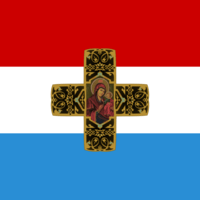Samara flag
The Samara flag (Bulgarian: Самарско знаме, Samarsko zname, Russian: Самарское знамя, Samarskoye znamya) is one of the most important military symbols of the Bulgarian Army. Sewed by local nuns and given to the Bulgarian volunteers in the Russo-Turkish War of 1877-78 by the citizens of the Russian city of Samara on 18 May 1877, it became famous when it was heroically prevented from being captured by the Ottoman forces in the Battle of Stara Zagora, with many soldiers perishing while protecting it from the enemy.

The flag, a tricolour 1.85 × 1.90 m in size, was sewed from thin silk cloth and has the pan-Slavic colours (red, white, blue). Icons of the Holy Mother of God and Cyril and Methodius were drawn on it in a golden cross by the Saint Petersburg artist Nikolay Simakov. It has a silver point designed by Graf Rochefort. The flag, originally intended for the rebels of the April Uprising, was handed to the Bulgarians near Ploieşti on 18 May, having been transported through Chişinău, where it was on 1 May. A delegation from the city of Samara, headed by Efim Kozhevnikov and Pyotr Alabin, handed the Samara flag to the volunteers in a special ceremony, with the flag being nailed using gold nails to its pole. The last nail was nailed by the old voyvoda Tseko Petkov, a leader of a band in the Troyan part of the Balkan Mountains for 30 years, who, with his fur cap taken off and with his eyes fixed at the sky, exclaimed:
May God let this holy flag pass from end to end through the long-suffering Bulgarian land. May our mothers, wives and sisters wipe their sorrowful eyes with it, and after it may durable peace come, and prosperity!
His words were followed by a storm of cheers and a cap toss.
The flag, entrusted to the 3rd battalion of the Bulgarian volunteer corps, was part of the battles at Stara Zagora and Nova Zagora, where a number of colour-bearers perished protecting it (including Lieutenant-Colonel Pavel Kalitin), as well as the Battles of Shipka Pass and Sheynovo.
The Samara flag, initially kept in Radomir from where its last bearer Pavel Korchev descended, was housed in the royal palace in Sofia (now the National Art Gallery) between 1881 and 1946, when it was transferred to the National Museum of Military History (NMMH). It has remained there ever since, preserved in a chamber under special conditions.
Two copies of the flag were made in 1958, one of which was sent to the Central Military Museum in Russia. Another two were made afterwards, one of which in 1978 in the NMMH restoration workshop by Mihail Maletski. The nuns of the Russian-founded Knyazhevo Nunnery of the Shroud of the Most Holy Mother of God gave the NMMH another precise copy made by them in 2006.
The Samara flag is the only flag awarded the Bulgarian Medal for Bravery, the medal being implanted in its pole's richly decorated point. The flag has been portrayed numerous times by noted artists, the most famous paintings featuring it being arguably The Samara Flag by Jaroslav Věšín from 1911 and Handing of the Samara Flag to the Bulgarian Volunteer Corps in Ploieşti by Nikolay Dmitriev-Orenburgsky. The contemporary flag of Russia's Samara Oblast (image) was based on the Samara flag when it was adopted in 1998.
The Flag Monument of Stara Zagora is a concrete replica of the Samara flag and commemorates the deaths of Bulgarian soldiers in the Russo-Turkısh War of 1877-78.
Gallery
 Authentic replica of the Samara flag in the Shipka Monument
Authentic replica of the Samara flag in the Shipka Monument Handing of the Samara Flag (Nikolay Dmitriev-Orenburgsky)
Handing of the Samara Flag (Nikolay Dmitriev-Orenburgsky)
 The Samara Flag (1911, Jaroslav Věšín)
The Samara Flag (1911, Jaroslav Věšín)
References
- "Монахините от Княжевския манастир ушиха копие на Самарското знаме" (in Bulgarian). Dnes.bg. 2006-03-24. Retrieved 2006-11-25.
- "Samara Region Administration — The History of the Flag". Samara.ru. Archived from the original on 2006-10-09. Retrieved 2006-11-25.